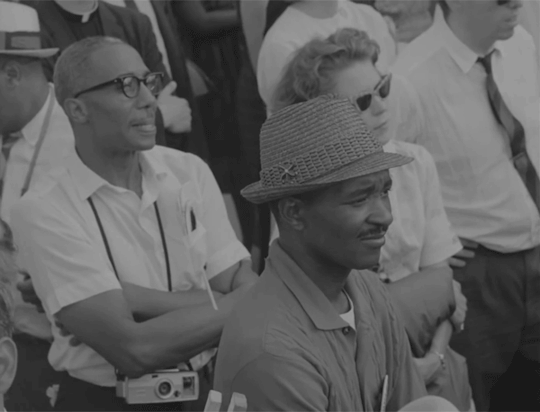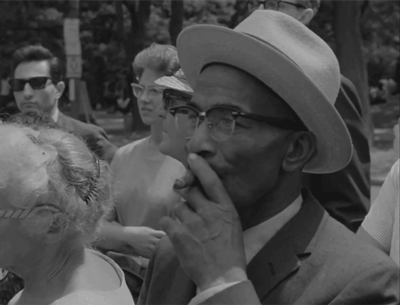Don't wanna be here? Send us removal request.
Photo







Speakers and Musicians at the March on Washington
Of all speakers, none was more memorable than Martin Luther King, Jr., who delivered his famous “I Have a Dream” speech during the program (transcript here).The still photo at the top is from the National Archives, ARC Identifier: 542068.
Part of a week-long series of gifs from The March, the James Blue documentary about the 1963 March on Washington for Jobs and Freedom, restored in 2013 by The National Archives. You can view it online here.
20K notes
·
View notes
Photo

“Life’s tragedy is that we get old too soon and wise too late.” — Benjamin Franklin (born January 17, 1706) http://stuf.ly/2jk2F75
145 notes
·
View notes
Photo

“It’s your outlook on life that counts.” — Betty White (born January 17, 1922) http://stuf.ly/2jVZL7n
68 notes
·
View notes
Text
The SPEAKING model was developed by Sociolinguist Dell Hymes to account for all of the different factors that are involved in speaking. It’s a good strategic planning tool to use to think ahead and to prepare when entering a particular communicative situation. Elements of the model also act as tools for reflection so that you can assess and evaluate what took place once a meeting has finished. Here is the model: •Situation: Setting and scene •Participants •Ends •Acts •Key •Instrumentalities •Norms •Genres The Setting and Scene of a meeting can help you envisage what kind of encounter is planned by your boss. Setting refers to the time and place. Scene is a culturally-defined occasion. In some workplaces, informal meetings without agendas may be the norm, in others, formal meetings with a carefully-planned agenda would always be expected. Participants refers to the exact people who are taking part: Who is invited and what role responsibilities do they have? Who is the Chairperson? Who is taking the minutes? Is there a formal agenda? Who has been pre-allocated to take the conversational floor? Do you have a pre-allocated turn? Does it look like you will get the opportunity to take the conversational floor if you have an important point to make? Ends: What goals does the communicative event serve, and what are the ideal outcomes? What does your boss aim to get out of this meeting? Does this differ from your purpose(s)? Acts: Exactly what is spoken and how it is delivered in a meeting. What can this tell you about your boss’s attitudes? You can reflect on these elements after the meeting has taken place. Key: The manner or tone in which something is said. Is your boss being sarcastic or antagonistic? Are they being supportive? What verbal and non-verbal cues can you use to decide this? Instrumentalities: What channel(s) of communication are used? Spoken? Written? Electronic? Most commonly in meetings you will have a combination of spoken and written channels, with written language of minutes, documents for circulation and agendas providing one communicative process, which then integrates with verbal and non-verbal communication. Norms: Refers to cultural norms of interaction and interpretation. How loud are people speaking? How do you gain the conversational floor? (See Step 1.13). Do you have to put up your hand? Do you have another mechanism to signal that you wish to take the floor? What happens if different norms clash? Genres: the language typically associated with a particular speech event. So, this refers to how the language used in meetings is distinct and differs from casual conversation that you may have with your boss outside of meetings.
0 notes
Text
Cultural Differences in Meetings
“The purpose of a meeting depends on where one is coming from. Britons and Americans see a meeting as an opportunity to make decisions and get things done. The French see it as a forum where a briefing can be delivered to cover all aspects of a problem. They hunger for elegant processes. Germans, more concerned with precision and exactness, expect to gain compliance. Italians use meetings to evaluate support for their plans. The Japanese regard the first few sessions as occasions for establishing status and trust and finding out what possible sources of discord need to be eliminated from the outset.”
0 notes
Text
Analytical tips 1
Discourse markers: a transition in talk and speaker attitude - “okay” and “right” a marker of hesitation “erm”, then stating “so that’s all for that really” Adjacency pairs: These are stretches of talk where two elements need to be spoken in order for a sequence to be viewed as properly completed. Question - Answer. Directness: Steve issues an order in a direct, unmitigated manner Intonation: There is rising intonation - full september? Boosters: Steve uses “I think” to increase or ‘boost’ the force Gaze and Gesture: Steve spends a long time looking down at his mobile phone because his penis is in his pants Analytical tips 2 Inclusive ‘we’ - collective responsibility. Supportive overlaps - “oh fantastic” Questions as indirect orders “do you think…?” Collective decision-making: “let’s” •Compliance checking “is that okay Matt?” (open-ended - how does that sound?) Gaze and gesture Steve engages Matt in much more frequent eye contact and he does not touch his phone. His non-verbal communication signals interest, enthusiasm and full engagement. Inclusiveness may work better if people are happy to let a person be the boss.
0 notes
Text
Rapport Management
A useful way of conceptualising sociality rights is to think about a cost-benefit continuum. If workers think that there is too much cost and not enough benefit to them, in terms of the tasks that they are being asked to perform, then they may stop performing effectively. Disharmony and conflict can result, and employees may well leave an organisation if they are able to do so. A further component of sociality rights is a scale of autonomy and imposition. This refers to the amount a boss imposes on others legitimatey versus the amount of autonomy that you are awarded. So generally speaking, there's a balance to be struck here between being imposed upon legitimately by your boss and your boss giving you more autonomy to make certain decisions. And to give you the space to go off and be more independent and enterprising. Of course, it's important to point out that even in the most harmonious of workplaces, there may well be occasional periods of conflict and miscommunication. The key here is how effectively these are dealt with. If issues can be resolved swiftly with everyone paying careful attention to one another's face needs by respecting sociality rights, then good rapport can be quickly re-established and harmony can be restored with professional identities being constructed in positive and effective ways.
0 notes
Text
Successful Bosses
Research has shown that successful bosses are those who have the following personality traits: •High levels of openness; emotional balance; confidence (the opposite end of the scale to neuroticism). •Sociable and dominant (towards the extrovert end). •An ability to move along the agreeableness scale based on context and the task at hand e.g., on some occasions, empathy and compassion will be required, on others a need for decisiveness and challenging behaviour will be required.
0 notes
Text
Good Bosses
"Good bosses, in modern businesses and organisation, are generally those whose pub-lic self image is judged as being authentic and inspirational, trustworthy, genuine and consistent, someone who's got a strong sense of stewardship and a dedication to developing a strong sense of workplace community."
0 notes